10 Best Agile Tools for Scrum Teams 2025
Explore the top 10 Agile tools for Scrum teams in 2025, designed to enhance sprint planning, collaboration, and project management.

Agile teams need tools that simplify sprint planning, backlog management, and team collaboration while supporting key Scrum practices like daily stand-ups, retrospectives, and velocity tracking. Here’s a quick breakdown of the top 10 Agile tools for Scrum teams in 2025:
- Jira Software: Best for large teams needing advanced customization and reporting.
- ClickUp: Ideal for teams looking for an all-in-one solution with flexible workflows.
- Trello: Great for small teams with simple, visual Kanban boards.
- Asana: Perfect for cross-functional teams with strong collaboration features.
- Monday.com: Offers visual dashboards and AI-driven tools for sprint efficiency.
- Azure DevOps: Designed for development-focused teams with built-in CI/CD tools.
- GitLab: Combines Agile project management with DevOps capabilities.
- Targetprocess: Tailored for scaled Agile frameworks like SAFe.
- Shortcut (formerly Clubhouse): Simplifies workflows for growing software teams.
- VersionOne: Best for large-scale enterprises managing multiple Agile teams.
Quick Comparison
| Tool | Best For | Key Features | Starting Price (Monthly) |
|---|---|---|---|
| Jira | Enterprise teams | Scrum boards, advanced reporting, roadmaps | $7.75/user |
| ClickUp | All-in-one solution | Custom views, time tracking, integrations | $7/user |
| Trello | Small teams | Kanban boards, Power-Ups, automation | $5/user |
| Asana | Cross-functional teams | Timeline views, workload management | $10.99/user |
| Monday.com | Visual project management | Dashboards, automations, AI tools | $8/user |
| Azure DevOps | Development teams | Repos, pipelines, test plans | $6/user |
| GitLab | DevOps-centric teams | CI/CD, issue tracking, security tools | $19/user |
| Targetprocess | Scaled Agile implementations | Portfolio management, visual reports | Custom pricing |
| Shortcut | Growing software teams | Epics, iterations, velocity tracking | $8.50/user |
| VersionOne | Large-scale Agile organizations | Portfolio planning, program management | Custom pricing |
Each tool caters to different needs, from simple task management to enterprise-level Agile frameworks. To choose the best tool, consider your team size, budget, and technical requirements. Test free trials to find the one that fits your workflow.
8 Top Scrum Project Management Tools Reviewed
Must-Have Features in Agile Tools
The right features in Agile tools can make a huge difference for Scrum teams. Here's a breakdown of key features and how they can fit into your workflow:
Sprint Planning and Management
Agile tools should let you customize sprint durations and manage workloads effectively. They should also help you organize tasks into sprints, set clear goals, and monitor progress using real-time dashboards.
Backlog Management
A well-structured backlog is essential. Look for tools that support:
- Story point estimation
- Priority ranking
- Custom fields for extra details
- Drag-and-drop reordering for flexibility
Visualization and Reporting
Visual tools help track progress and identify bottlenecks. Useful features include:
- Kanban boards for workflow visualization
- Burndown charts to monitor sprint progress
- Velocity charts to evaluate team performance trends
- Cumulative flow diagrams to analyze workflows
Team Collaboration Features
Strong communication tools are a must in Agile environments. Features to look for include:
- Real-time commenting with @mentions
- File sharing and document management
- Integration with communication platforms
- Activity streams to track project updates
Advanced Analytics
Tracking key metrics can help fine-tune your processes. Examples include:
| Metric Type | Purpose | Impact |
|---|---|---|
| Velocity Tracking | Measures team output consistency | Helps with sprint planning |
| Cycle Time Analysis | Tracks task completion speed | Identifies areas for improvement |
| Sprint Health Indicators | Tracks progress toward goals | Flags potential issues early |
| Resource Utilization | Monitors team workload | Aids in capacity planning |
Customization and Integration
Your Agile tool should adapt to your team's needs and work seamlessly with your existing tech stack. Important integrations include:
- Version control systems like Git
- CI/CD pipelines
- Testing tools
- Documentation platforms
Security and Access Control
Ensure the tool includes enterprise-grade security features such as:
- Role-based access control
- Single Sign-On (SSO)
- Audit logs
- Data encryption
Mobile Accessibility
With remote work on the rise, mobile access is more important than ever. Look for tools that offer:
- Native apps for iOS and Android
- A responsive web interface
- Offline functionality
- Push notifications for critical updates
The best Agile tools combine powerful features with user-friendly design, ensuring they meet the needs of modern teams.
1. Jira Software
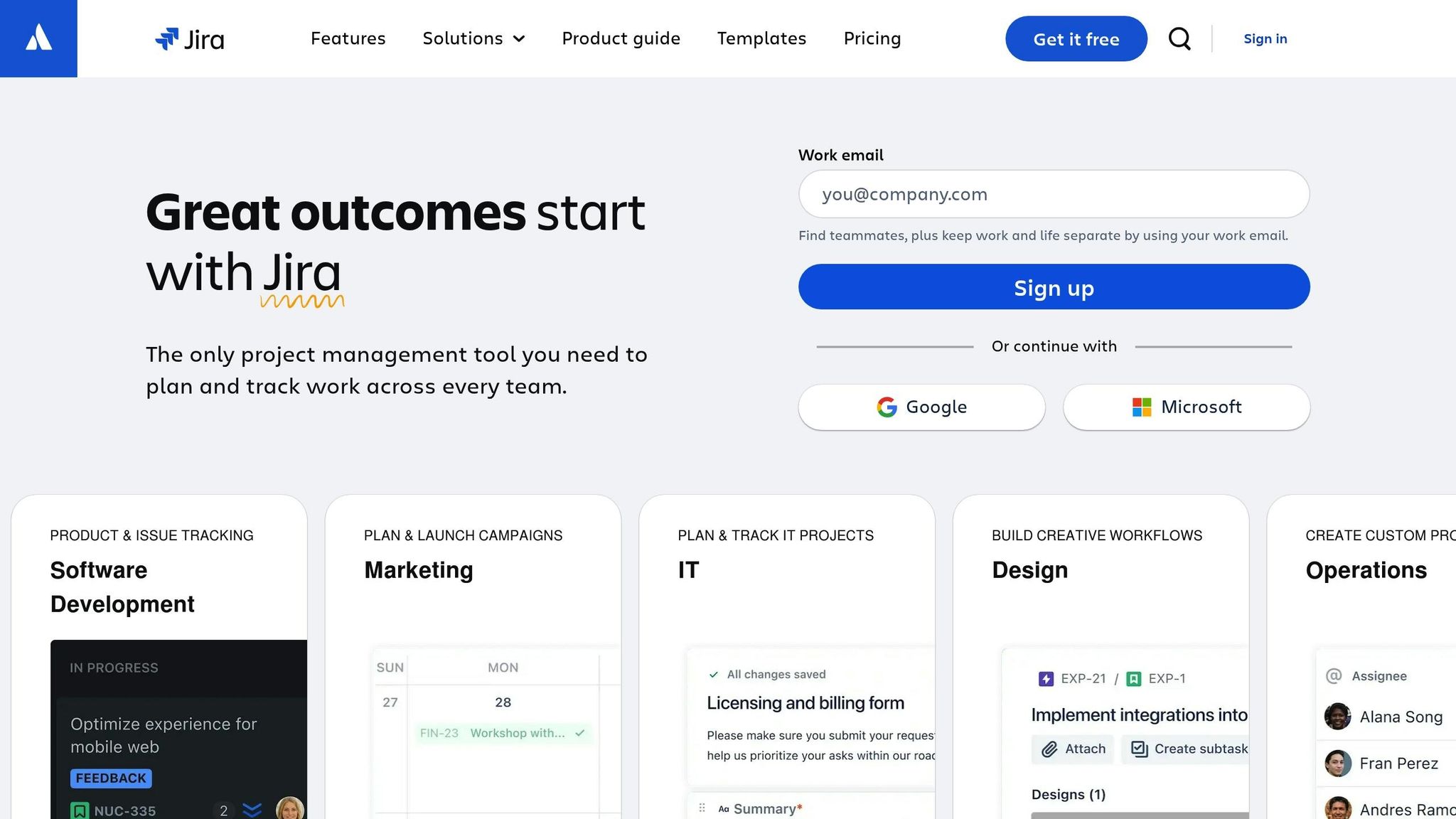
Jira Software is a top choice for enterprise Scrum, offering powerful tools to handle complex project management needs.
Key Scrum Features
Jira helps teams efficiently manage their Scrum processes by enabling them to:
- Plan and run sprints with adjustable timeframes
- Set sprint goals and monitor velocity
- Track progress using burndown charts
- Use story point estimation for workload planning
Customization Options
The platform allows teams to tailor workflows to their needs through custom issue types, configurable workflows, automated rules, and personalized board setups.
Integration Capabilities
Jira integrates seamlessly with a wide range of tools, enhancing its functionality:
| Category | Key Integrations | Purpose |
|---|---|---|
| Version Control | GitHub, Bitbucket, GitLab | Simplifies issue tracking |
| Communication | Slack, Microsoft Teams | Provides real-time updates |
| Documentation | Confluence, SharePoint | Centralizes knowledge sharing |
| Development Tools | Jenkins, Bamboo | Streamlines CI/CD pipelines |
Reports and Analytics
Jira delivers in-depth reporting features, including:
- Velocity tracking across sprints
- Sprint and release burndown charts
- Cumulative flow diagrams for workflow analysis
- Advanced filtering using JQL (Jira Query Language)
Pricing Plans
Jira offers three pricing tiers to suit different needs:
- Free: Supports up to 10 users
- Standard: $7.75 per user/month
- Premium: $15.25 per user/month
Who Should Use Jira?
Jira is ideal for:
- Large teams in need of a scalable solution
- Organizations with intricate workflows
- Teams requiring advanced customization options
- Projects that demand detailed tracking and analytics
While Jira has a steep learning curve, its comprehensive features make it a go-to tool for Scrum teams. Its strong security measures, including SOC2 and ISO 27001 solutions, make it a reliable choice for organizations with stringent security needs.
Jira's extensive capabilities set a high standard as we delve into other Agile tools.
2. ClickUp
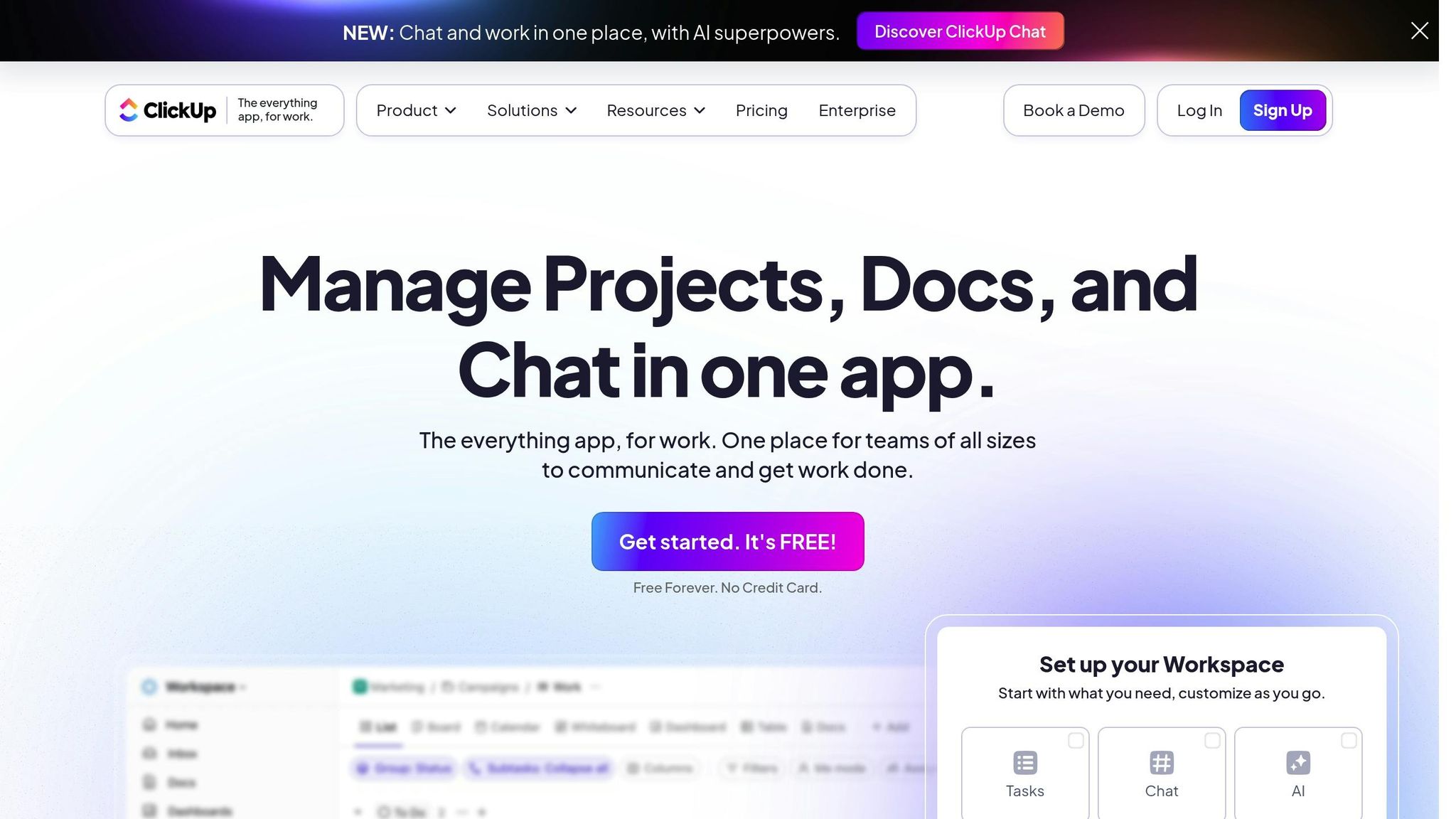
ClickUp enhances Scrum team efficiency with a variety of integration options and flexible workflows, making it easy for teams to adjust processes to their specific requirements. Here's a breakdown of its key features, including customizable views, integration options, and advanced workflow tools.
Customizable Views
ClickUp provides several view types to help teams manage their work effectively:
| View Type | Purpose |
|---|---|
| Board View | Ideal for Kanban workflows and sprint management |
| List View | Organizing backlogs and prioritizing tasks |
| Timeline | Planning releases and mapping dependencies |
| Calendar | Scheduling sprints and tracking milestones |
Integration Options
ClickUp integrates with a wide range of tools that are essential for Scrum teams, such as:
- Development Tools: GitHub, GitLab, Bitbucket
- Communication Platforms: Slack, Microsoft Teams, Zoom
- File Storage: Google Drive, Dropbox, OneDrive
- Time Tracking: Harvest, Toggl, Time Doctor
These integrations allow teams to connect their favorite tools directly within ClickUp, creating a more streamlined experience.
Advanced Workflow Tools
ClickUp also offers advanced features like custom fields, automation options, and pre-built Scrum templates, giving teams the flexibility to design workflows that fit their unique processes.
3. Trello
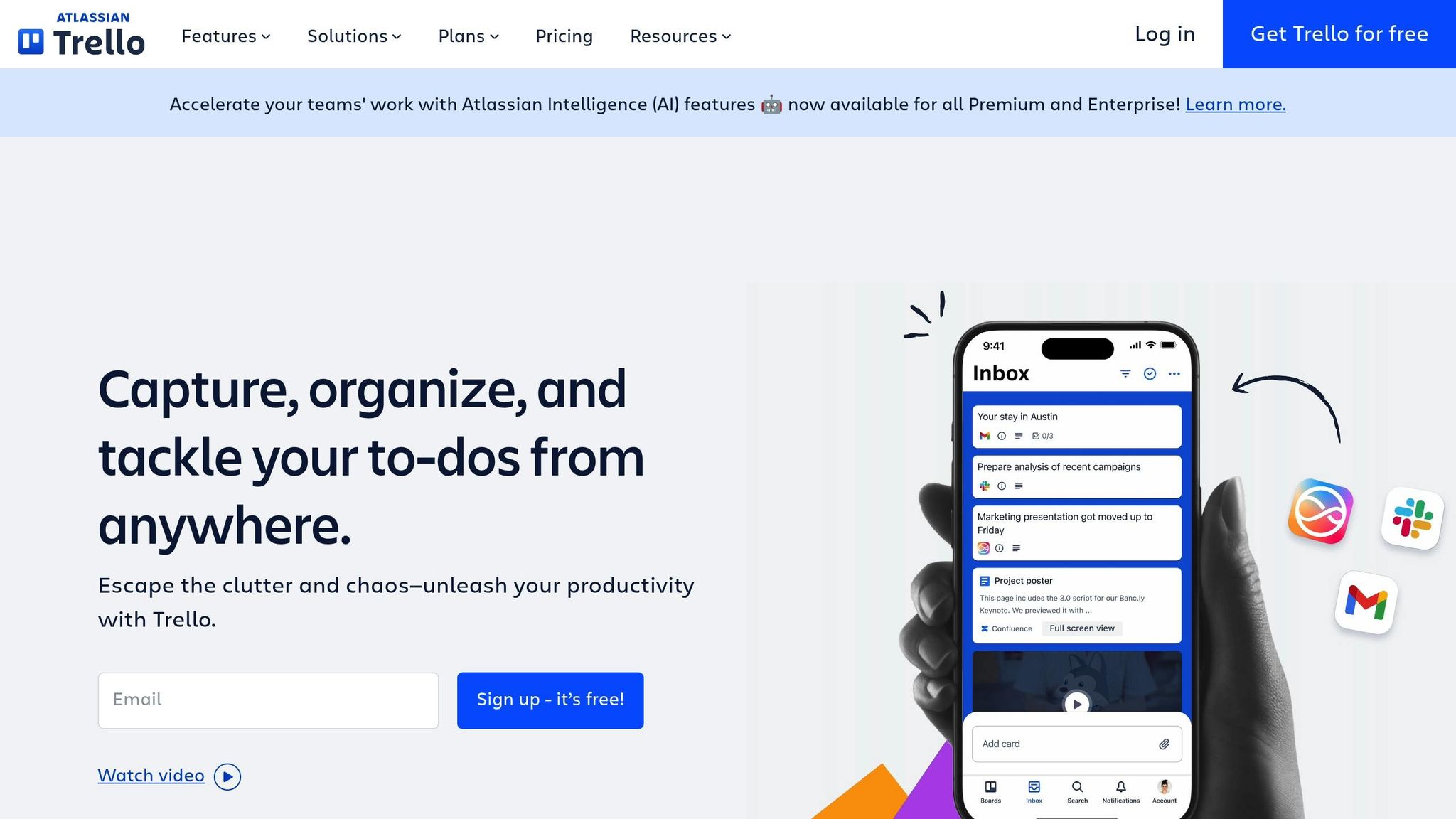
Trello takes Agile features and makes them visually intuitive, making it a popular choice for Scrum teams. Its card-based interface is great for sprint planning, backlog organization, and tailoring workflows to your needs.
- Power-Ups: Add features like burndown charts, time tracking, and custom fields
- Butler Automation: Simplifies tasks like card updates and sprint transitions
- Board Templates: Ready-to-use setups for sprints, backlogs, and roadmaps
- Checklists: Break down user stories into manageable subtasks
Trello's board system fits right into Scrum workflows. You can manage product backlogs, plan sprints, track ongoing tasks, organize releases, and document retrospectives. With Power-Ups, you can integrate Trello with popular tools like GitHub, Bitbucket, Slack, Microsoft Teams, Confluence, Google Drive, Harvest, and Toggl.
Customization is a breeze, thanks to features like custom fields, labels, card aging, and automation rules. Plus, Trello's mobile apps for iOS and Android let team members update cards, check sprint details, get notifications, and collaborate from anywhere.
Trello offers a free plan for small teams. For more advanced needs, the Business Class plan costs $10 per user per month, and the Enterprise plan starts at $17.50 per user per month.
4. Asana

Asana offers an easy-to-use platform with powerful tools to simplify Scrum workflows. Its Timeline view and customizable boards help teams efficiently plan and execute sprints.
Key Agile Features:
- Sprint planning with ready-to-use templates
- Kanban boards for visual task tracking
- Tools for managing dependencies and milestones
- Real-time collaboration features
- Custom fields to track story points and priorities
The Timeline view allows teams to map out dependencies and adjust schedules as needed. Asana's Forms make issue reporting straightforward, while the Portfolio view provides a centralized overview of multiple projects.
For Scrum ceremonies, Asana’s flexibility shines. Teams can create tailored projects and sections to fit their workflow. For example, custom fields can help set priorities during sprint planning, post updates for daily standups, monitor progress during sprint reviews, and gather feedback during retrospectives.
Asana integrates seamlessly with tools like GitHub, Slack, Microsoft Teams, and Google Workspace. Its Rules feature automates repetitive tasks, ensuring workflows stay consistent and efficient.
Pricing Structure:
- Basic (Free): Core features for small teams
- Premium: $10.99 per user/month (billed annually)
- Business: $24.99 per user/month (billed annually)
- Enterprise: Custom pricing for large organizations
For most Scrum teams, the Premium plan includes essential Agile tools like Timeline views, custom fields, and advanced reporting. Larger organizations managing multiple teams may find the Business plan’s portfolio management and security features more suitable.
Asana’s mobile apps for iOS and Android keep teams connected, enabling them to update tasks, check sprint progress, and engage in discussions from anywhere. The offline mode ensures work continues uninterrupted, syncing updates automatically once a connection is restored.
5. Monday.com
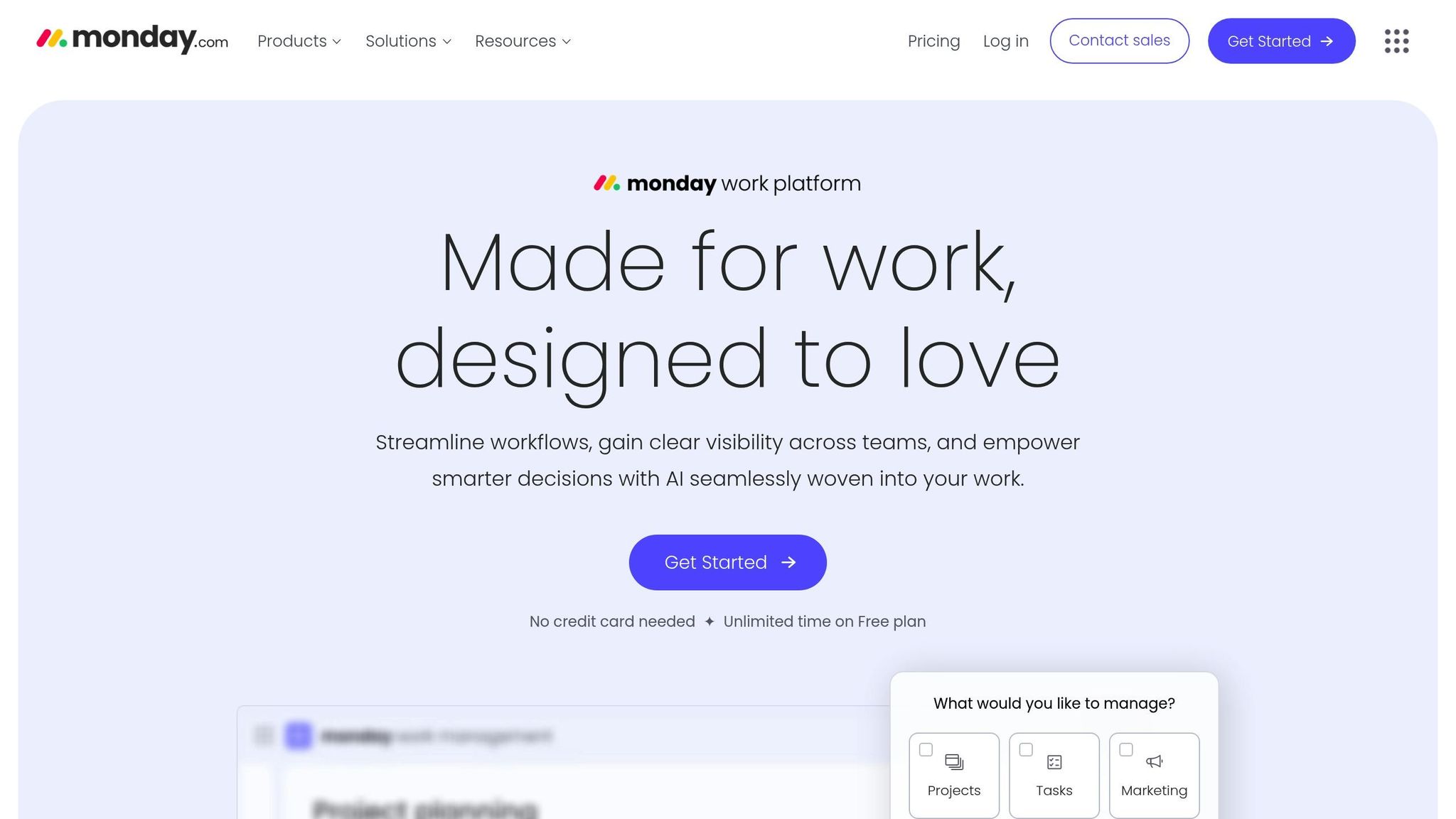
Monday.com supports enterprise Scrum teams and is trusted by 61% of Fortune 500 companies. Its monday dev product is designed to boost sprint efficiency and simplify development workflows.
Key Features for Agile Teams
Here’s what makes Monday.com stand out for Scrum teams:
- Customizable workflows for sprint management
- Tools for creating and visualizing product roadmaps
- AI-driven bug tracking and categorization
- Real-time progress tracking
- Resource allocation and capacity planning
- Visual dashboards for flexible sprint planning
These tools have proven their effectiveness in practical applications.
Real-World Success Stories
Take Canva as an example. They reported impressive results using Monday.com:
"The fact that we've been able to adjust and adapt monday.com to meet our needs at two different times was incredibly important to us."
– Vic Diesta, Creative Ops Lead
Canva saw a 40% faster production time, tripled their creative output, and eliminated 657 manual actions.
Monday.com also integrates with hundreds of tools through an open API, ensuring smooth connections across your toolchain for a unified workflow.
Motorola reported a 346% ROI after adopting the platform. Zippo shared similar success:
"monday.com has enabled our group to launch more product categories and expand into more markets in way less time."
Additionally, AI features like automated bug categorization and risk analysis help Scrum teams focus on delivering value instead of getting bogged down by routine tasks.
6. Azure DevOps
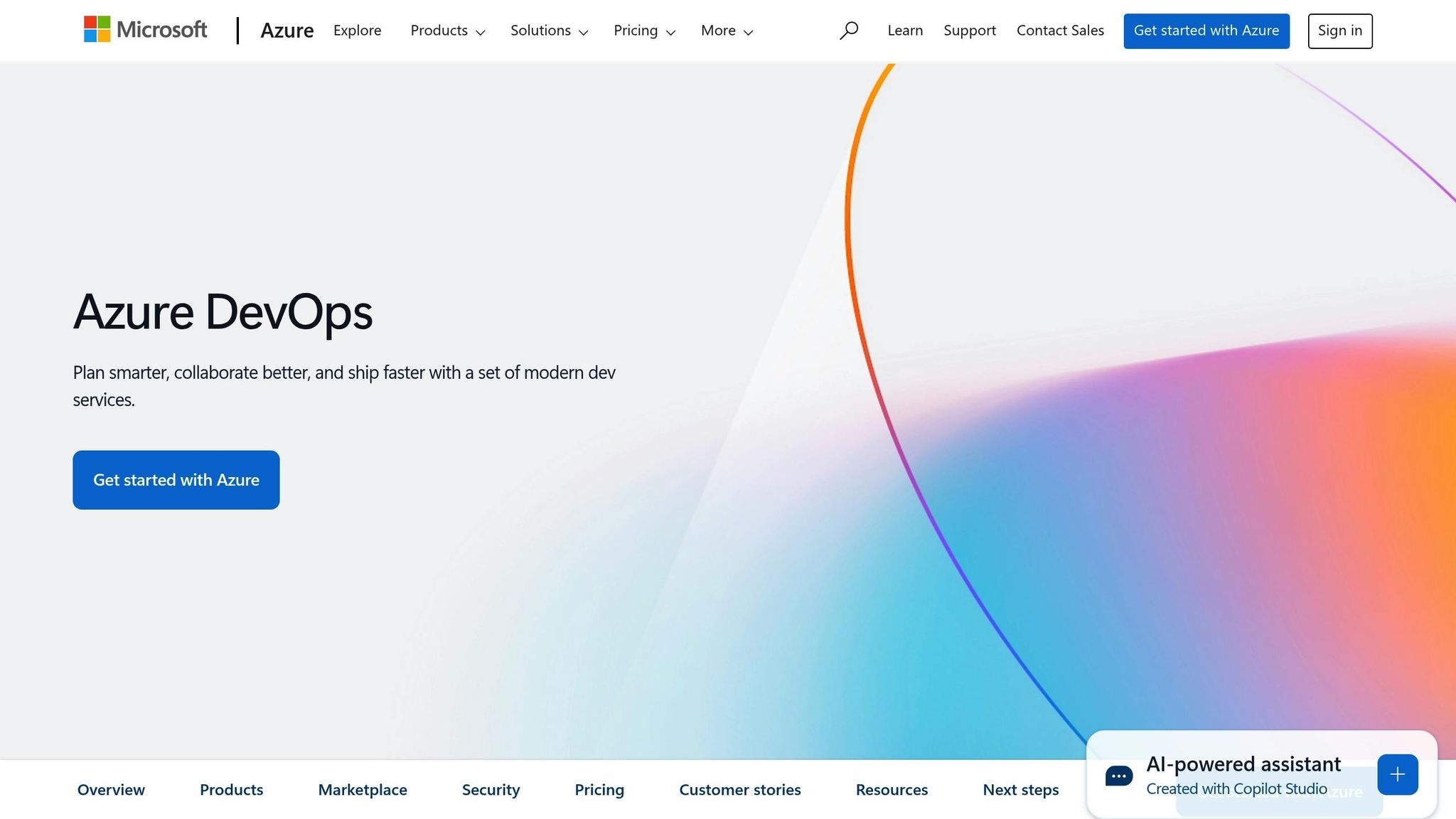
Azure DevOps offers a powerful solution for Scrum teams in enterprise settings, combining Agile practices with strong DevOps tools to bridge the gap between development and operations.
Scrum Features Built for Enterprises
Azure DevOps supports large-scale Scrum projects with features like:
- Sprint Planning Tools: Built-in tools for capacity planning help teams estimate and allocate work effectively across sprints.
- Customizable Kanban Boards: Boards can be tailored with swim lanes, WIP limits, and custom states to fit your workflow.
- Portfolio Management: Manage backlogs at multiple levels to keep enterprise projects organized.
- Test Case Management: Plan and execute tests directly within the platform.
- Git Integration: Includes native source control, with branch policies and pull requests for streamlined collaboration.
Integration Options
Azure DevOps stands out with its wide range of integration options:
| Integration Type | Key Tools and Features |
|---|---|
| Development Tools | Visual Studio, VS Code, Eclipse |
| CI/CD Pipeline | Jenkins, Docker, Kubernetes |
| Cloud Services | Azure, AWS, Google Cloud |
| Monitoring | Application Insights, New Relic |
These integrations are supported by strong security features, ensuring smooth and secure workflows.
Security and Compliance Features
Azure DevOps meets enterprise security requirements with:
- Advanced Authentication: Includes multi-factor authentication and conditional access.
- Role-Based Access: Set detailed permissions for team members.
- Audit Logging: Tracks activity and provides compliance reports.
- Data Encryption: Ensures data is secure both at rest and in transit.
Built-In Performance Analytics
Azure DevOps provides analytics to track team performance and project health, including:
- Sprint Velocity: Monitors past and projected velocity to help teams plan better.
- Cycle Time: Tracks lead and cycle times for process improvement.
- Quality Metrics: Measures code coverage and test pass rates to ensure quality.
- Team Health: Uses sprint burndown charts and cumulative flow diagrams to assess progress.
These analytics, combined with its features, make Azure DevOps a strong choice for teams already using Microsoft tools, offering scalability and efficiency across projects.
7. GitLab
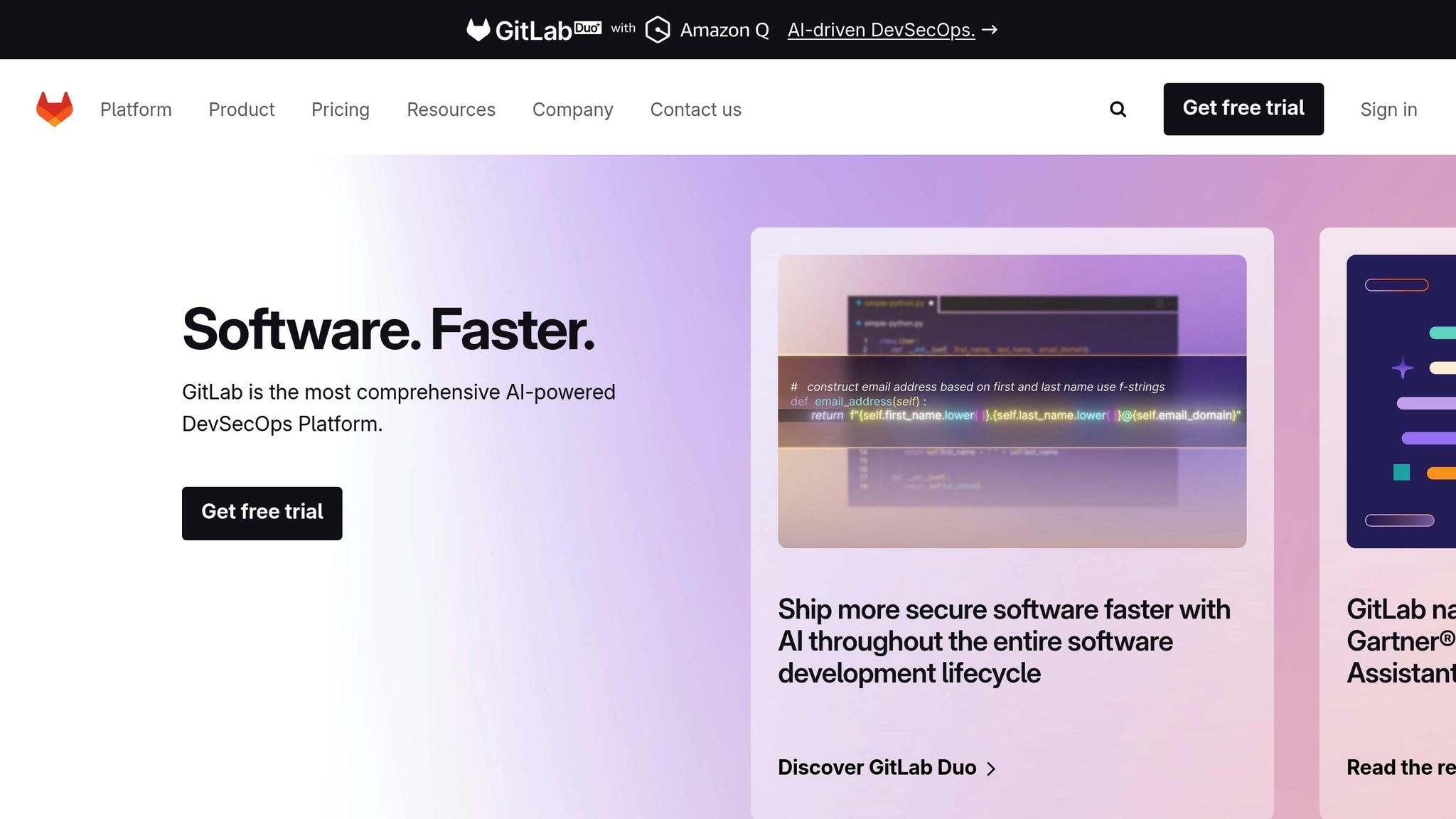
GitLab stands out as an all-in-one DevOps platform, tailored for Agile project management.
Agile Features Built for DevOps
GitLab's Agile tools work seamlessly with its version control system, offering:
- Epic Tracking: Organize large-scale initiatives across various projects and teams.
- Issue Boards: Customizable Kanban boards that sync automatically with code updates.
- Time Tracking: Track time estimates and logs directly within issues.
- Value Stream Analytics: Analyze team performance and pinpoint delays.
- Milestone Planning: Group tasks into sprints or releases, complete with burndown charts.
Security Tools for Your Projects
GitLab also provides strong security features to safeguard your work:
| Feature | Functionality |
|---|---|
| Container Scanning | Finds vulnerabilities in container images. |
| Dependency Scanning | Identifies risks in project dependencies. |
| SAST & DAST | Automates static and dynamic security testing. |
| Compliance Management | Includes frameworks and reporting for compliance. |
Streamlined Automation and CI/CD
GitLab simplifies Scrum workflows with automation tools like:
- Auto DevOps: Ready-to-use CI/CD pipelines.
- Review Apps: Automatically deploy branches for testing.
- Merge Request Approvals: Set up consistent approval processes.
- Pipeline Analytics: Gain insights into deployment frequency.
Collaboration Features for Teams
The platform boosts team collaboration with tools such as:
- Wiki Pages: Built-in documentation that stays up-to-date.
- Code Review: Integrated merge request approval workflows.
- Service Desk: Integrate customer feedback directly into development.
- Team Planning: Sprint planning tools with capacity management.
GitLab's unified platform reduces the need for multiple tools, cutting down on complexity. Plus, its self-hosted option gives teams more control over their environment.
8. Targetprocess
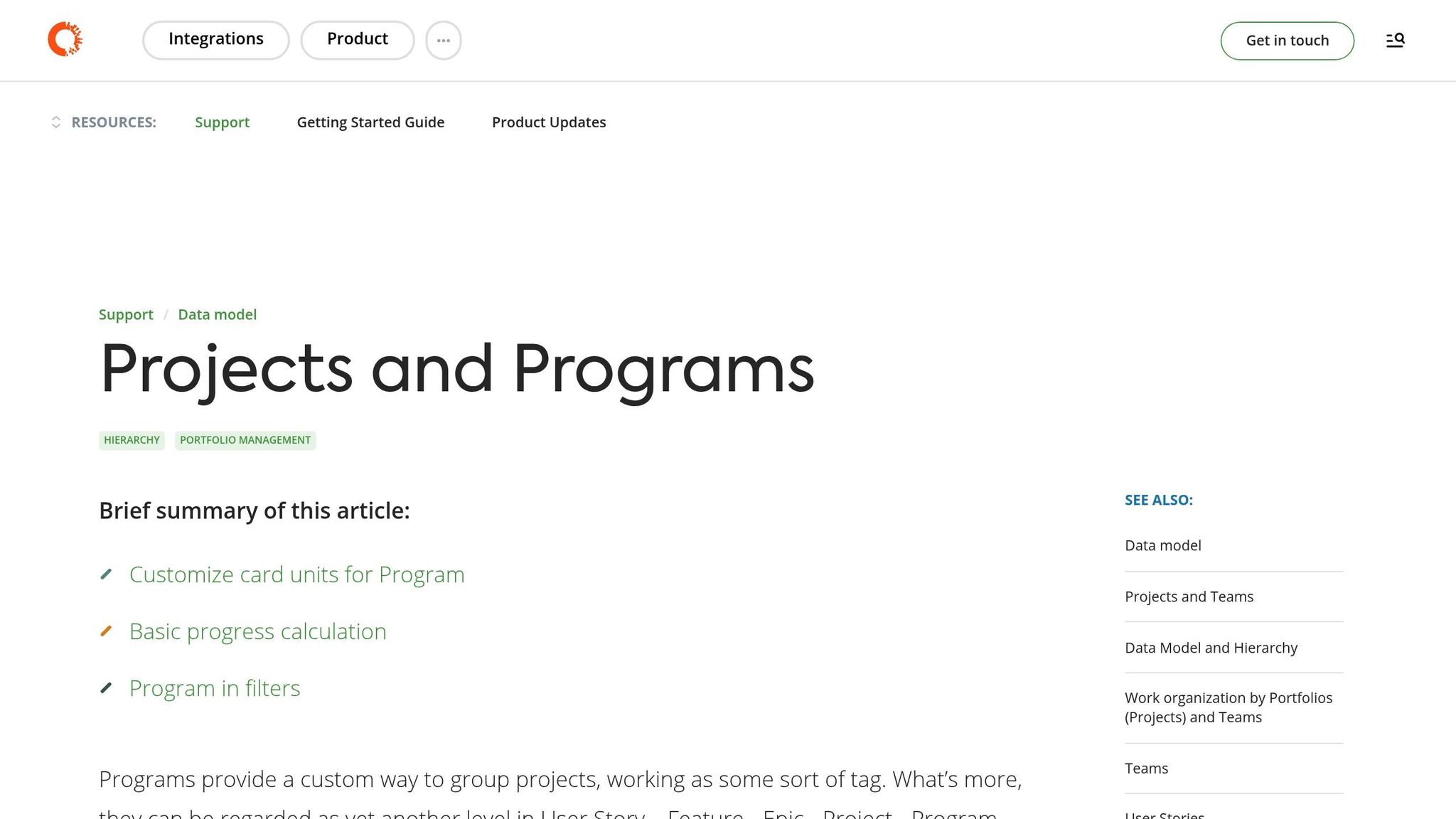
Targetprocess offers tools designed to support Agile frameworks like Scrum, making sprint planning and backlog management more efficient. Its visual approach helps teams handle complex projects with ease, offering tools tailored for organizing work and tracking progress.
Sprint Management Features
Targetprocess includes several tools to simplify sprint planning, such as:
- Visual Sprint Boards: Clearly display work items, dependencies, and progress.
- Capacity Planning: Evaluate team velocity and balance workloads effectively.
- Burndown Charts: Monitor sprint progress as tasks are completed.
- Release Planning Tools: Coordinate timelines across multiple sprints.
Customizable Work Views
For managing backlogs and daily tasks, Targetprocess offers flexible viewing options:
- Timeline Views: Ideal for release planning and milestone tracking.
- Kanban Boards: Provide a clear visual of workflows and task progression.
- List Views: Allow for quick and straightforward task organization.
With its focus on visual tools, Targetprocess helps Scrum teams stay organized, plan sprints effectively, and keep backlogs under control.
9. Clubhouse
Clubhouse, now known as Shortcut, is an Agile project management tool designed to simplify workflows for growing Scrum teams. It combines ease of use with essential features tailored to Agile practices.
Key Scrum Features
Shortcut supports Scrum teams by offering:
- Sprint planning and story estimation with automated progress tracking
- Customizable workflows to align with your team's processes
- Epic management for organizing work items hierarchically
- Automated velocity tracking to measure progress across sprints
Collaboration Tools
Shortcut enhances team communication and transparency with tools like:
- Instant notifications and activity feeds to keep everyone updated
- Integrations with platforms like GitHub, GitLab, and Slack
- A built-in wiki for team documentation
- Customizable fields to organize data effectively
These features aim to keep teamwork smooth and efficient while maintaining clarity.
Analytics and Reporting
Shortcut also delivers detailed performance insights through:
- Velocity charts to monitor team progress
- Burndown charts for sprint tracking
- Cycle time reports to analyze workflow efficiency
- Custom dashboards tailored for stakeholders
Pricing starts at $8.50 per user per month for small teams, with enterprise plans available for larger organizations. Its streamlined design makes it a great fit for teams moving from simpler tools to more advanced Agile management systems.
10. VersionOne
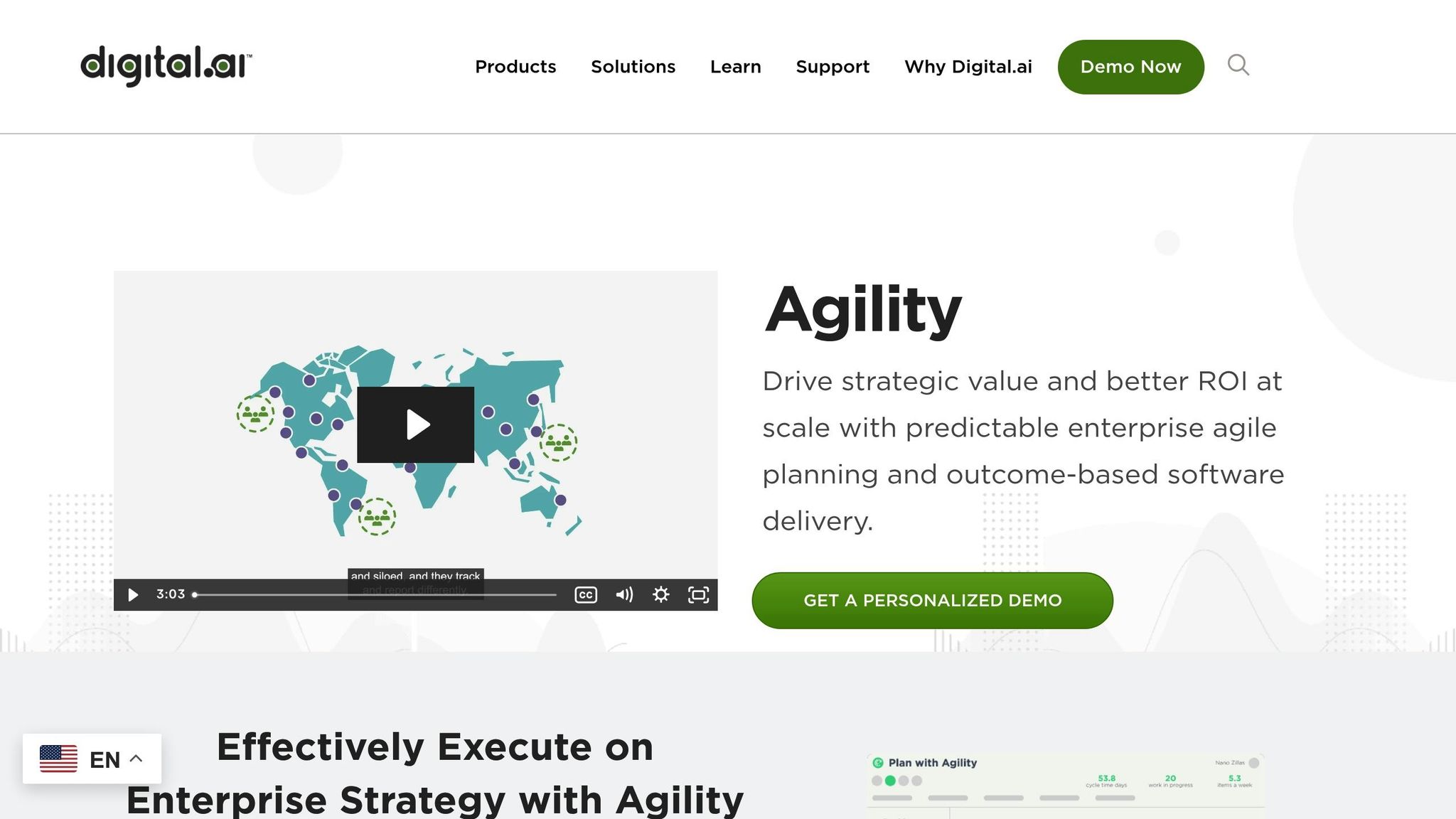
VersionOne, now part of Digital.ai, is an Agile platform designed for large-scale Scrum, helping organizations manage multiple teams and projects seamlessly. It offers a range of features grouped into key categories:
Enterprise Agile Features
- Portfolio Management: Connect strategic goals with on-the-ground execution.
- Program Management: Keep teams aligned and track cross-team dependencies.
- Release Planning: Oversee releases across various teams.
- Sprint Management: Plan and execute sprints with precision.
Advanced Analytics
- Real-time Metrics: Track performance and KPIs as they happen.
- Custom Dashboards: Tailor views for different stakeholders.
- Predictive Tools: Plan sprints with data-driven insights.
- Automated Reports: Simplify reporting processes.
Integrations
- DevOps: Built-in CI/CD connections.
- Source Control: Compatible with Git repositories.
- Testing Tools: Works with major testing platforms.
- Communication: Integrates with Slack and Microsoft Teams.
Core Capabilities
- Scalability: Handles organizations with over 1,000 users.
- Compliance: Includes audit trails and detailed reporting.
- Custom Workflows: Tailor processes to fit team needs.
- Security: Features role-based access and single sign-on (SSO).
While VersionOne has a learning curve, it provides a robust set of tools for organizations adopting SAFe or managing multiple Agile teams, making it a strong choice for enterprise-level Scrum implementations.
Tool Features and Pricing Chart
Below is a quick comparison chart summarizing the key features, integrations, and pricing of popular tools:
| Tool | Core Features | Integrations | Starting Price (Monthly) | Best For |
|---|---|---|---|---|
| Jira Software | • Scrum & Kanban boards • Advanced reporting • Custom workflows • Roadmaps |
Extensive integration ecosystem | $7.75/user | Enterprise teams needing customization |
| ClickUp | • Task dependencies • Time tracking • Custom views • Docs |
Multiple app integrations | $7/user | Teams seeking an all-in-one solution |
| Trello | • Kanban boards • Power-Ups • Automation • Templates |
Wide range of integrations | $5/user | Small teams and visual planning |
| Asana | • Timeline views • Workload management • Forms • Goals |
Key integrations for productivity | $10.99/user | Cross-functional collaboration |
| Monday.com | • Multiple views • Automations • Time tracking • Dashboards |
Robust integration options | $8/user | Visual project management |
| Azure DevOps | • Repos • Pipelines • Test plans • Artifacts |
Seamless integration with Microsoft tools | $6/user | Development-focused teams |
| GitLab | • CI/CD • Source control • Issue tracking • Wiki |
Strong DevOps integrations | $19/user | DevOps-centric teams |
| Targetprocess | • Portfolio management • Program boards • SAFe support • Visual reports |
Integrates with common Agile tools | Custom pricing | Scaled Agile implementations |
| Clubhouse | • Stories • Iterations • Epics • Reporting |
Standard tool integrations | $8.50/user | Software development teams |
| VersionOne | • Portfolio planning • Program management • Release tracking • Analytics |
Enterprise-level integrations | Custom pricing | Large-scale Agile organizations |
This chart highlights each tool's strengths at a glance.
Integration capabilities play a big role in boosting productivity. For example, Jira Software stands out with its wide integration ecosystem, making it a great fit for teams already using Atlassian tools like Confluence or Bitbucket. Azure DevOps works seamlessly with Microsoft tools, which is perfect for teams in a Microsoft environment. Similarly, GitLab is tailored for DevOps teams, offering powerful integrations for containerization and CI/CD pipelines.
Pricing Details
- Prices reflect annual billing as of March 2025.
- Free trials vary between 14–30 days.
- Enterprise plans are custom-priced and often include advanced features.
- Discounts may be available for nonprofit and educational organizations.
Keep in mind, costs and features can vary depending on team size and specific needs.
Summary and Selection Tips
When choosing an Agile tool, focus on these key factors to ensure it fits your team's needs:
Team Size and Complexity: Consider how large and complex your team is. For smaller teams, simpler tools like Trello or ClickUp offer enough functionality without being overwhelming. Larger organizations managing multiple teams may need more scalable options like Jira Software or VersionOne.
Budget: Look at the total cost of ownership, including training, implementation, per-user fees, and add-ons. Keep in mind that annual plans often come with discounts, which might save you money in the long run.
Technical Requirements: Match the tool to your development environment:
- Azure DevOps works best for teams using Microsoft technologies.
- GitLab is a strong choice for teams focused on DevOps practices.
- Jira Software stands out for its extensive third-party integrations.
Implementation Timeline: Simpler tools like Trello can be set up quickly, while enterprise-level solutions may take longer to deploy. Factor in the time needed for training and the availability of support resources.
Critical Features: Focus on tools that meet your most important operational needs.
Take advantage of free trials and demos, involving key team members to test the tool in your specific environment. This hands-on approach will help you gauge whether the tool aligns with your workflows.

